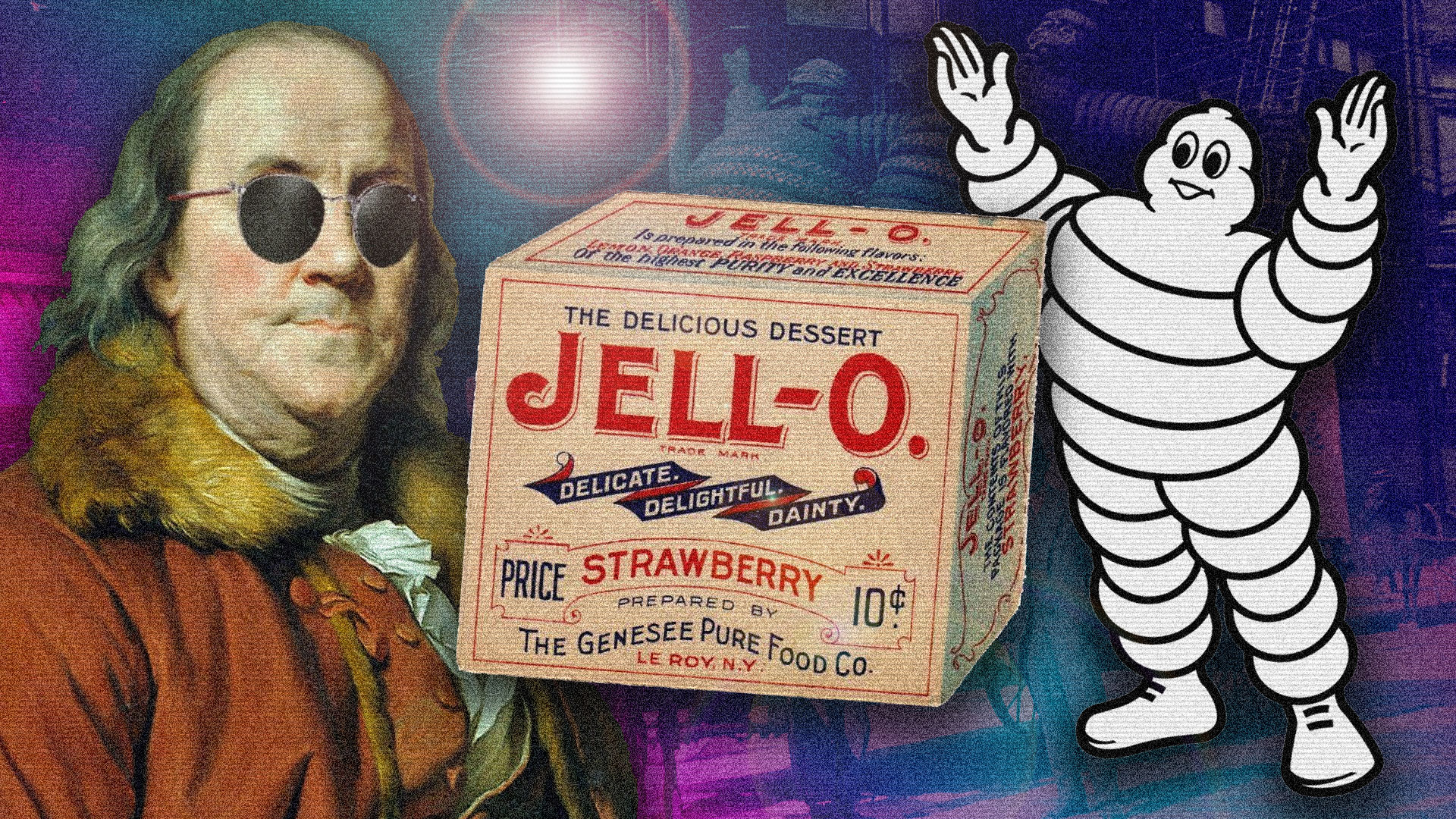If you publish content of some form online, whether it be via your blog or other means, it’s likely that you have either thought about or attempted to monetise your content.
Finding the right monetisation strategy for your business can be a challenge. However, each tactic has it’s own unique advantages and disadvantages.
Additionally, due to the variations within the marketing mix from business to business, it’s likely that not of the revenue streams of them will be suitable for your business.
In this article, we explain 6 alternative methods you can use to grow your businesses online revenue. If you have any questions or suggestions, please feel free to leave us a comment!
CPM DISPLAY ADVERTISING
Google Display Network, Uber CPM
CPM (cost per thousand) advertising is a traditional and rather outdated method of website monetization in which the advertiser is charged a fee from the website owner at a flat rate, according to the number of times the advertisement is shown to the website’s visitors.
Typically, CPM advertising can result in some cost-effective campaigns. The main downside of CPM however, is that the actions taken by the users often remain untracked. This makes for difficult campaign tracking as it is relatively futile to assume that users will be able to recall your ad, or take further actions based on mere exposure to a website banner.
CPC ADVERTISING
Google Adsense, Media.net
CPC (Cost Per Click) advertising is a modern version of the traditional CPM display ad model. With cost per click ads and as the name suggests, the advertiser is charged based on the number of clicks their advertisements receive.
In recent years, CPC Advertising has become much more popular in comparison to CPM advertising models, primarily due to one major player – Google Adsense.
The Adsense content network is powered by a wealth of data from Google and enables publishers to display relevant ads automatically on their website, to receive a share of the revenue when these ads are clicked.
AFFILIATE REVENUE
Amazon Affiliates, eBay Partner Network
Affiliate advertising is a commission based revenue system that in a sense, has a lot in common with the CPM and CPC strategies. Similarly, affiliate advertising relies on third party ads being placed on your website.
These ads come from affiliate advertising networks such as Amazon Affiliates, and provide the website owner with a commission for every sale generated as a byproduct of the ad placed on their site. Affiliate revenue can also be referred to as cost per acquisition marketing, or CPA.
Affiliate revenue streams can be a very natural addition to a hobby-blog or reviews website. For example, if you ran a site reviewing science fiction books, you could use Amazon affiliate links within your reviews to receive a portion of the profit.
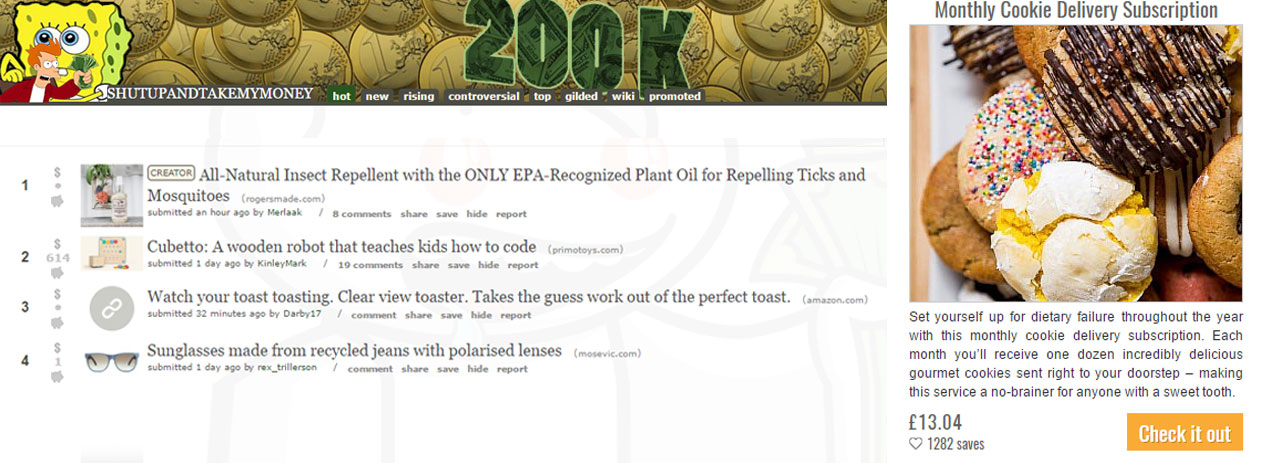
ThisIsWhyImBroke.com maintains a presence on Reddit, driving traffic to the which is then monitised via Amazon Affiliate commission
PAID-FOR SUBSCRIPTION
Netflix, The Guardian, Campaign Live, Spotify
While consumers become more comfortable with subscription-based services like Netflix and Spotify, a wide range of ‘all-you-can-eat’ subscription model have started to emerge.
As the trend of paying for unlimited access to digital content grows, and the consumer’s behaviour of increased media consumption becomes normalised, new opportunities for publishers and media brands will begin to emerge.
Subscription-based revenue has become increasingly more popular with mainstream news providers like The Guardian but this model can also be just as effective for niche, alternative media sources. As discussed in this article this subscription model has served as a successful alternative to CD revenue for those within the music industry
Perhaps the increased reliance from media companies on subscription based revenue, is a market reaction to the decreased effectiveness of banner ads, which has seen click through rates fall by 44% in recent years.
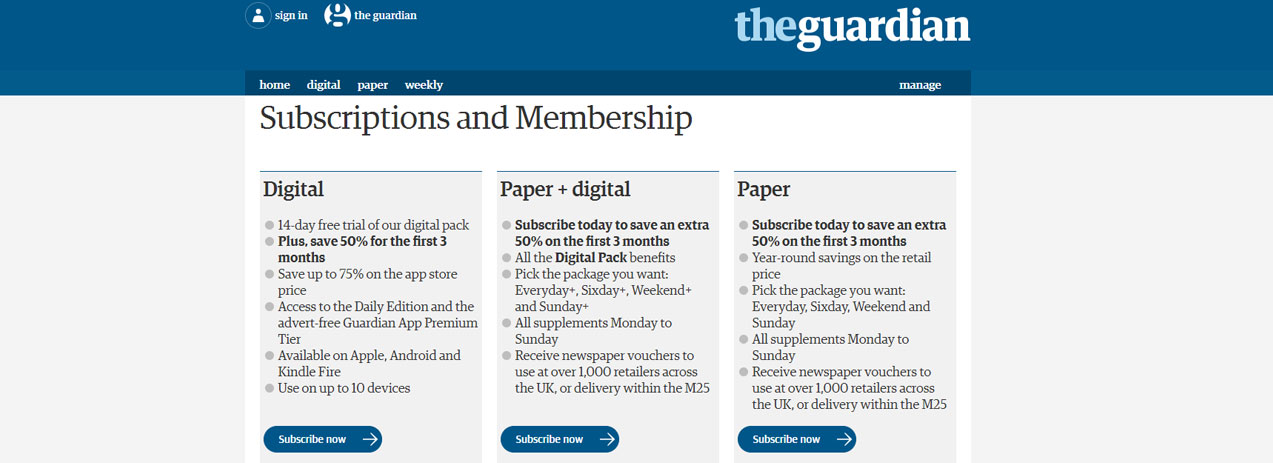
SPONSORED CONTENT
Business Insider, Campaign Live, Huffington Post
Sponsored Content is when a company pays a publisher to post or produce an article which advertises their services or discusses their agenda in a positive light. Many companies such as the New York Times, Huffington Post and Business Insider have developed ancillary revenue streams through this method of monetisation.
Having mainstream platforms publish content regarding your brand can be highly beneficial. However, sponsored content is also somewhat controversial. This is because sponsored content often lacks the collaborative and authentic nature of an organic story or guest post.
When striving to maintain brand authenticity, it is important for publishers to be upfront with readers about the presence of any sponsored articles. If you are being paid to review electronic products and you do not include a disclosure notice, it could be a huge blow to your credibility if discovered by your audience.
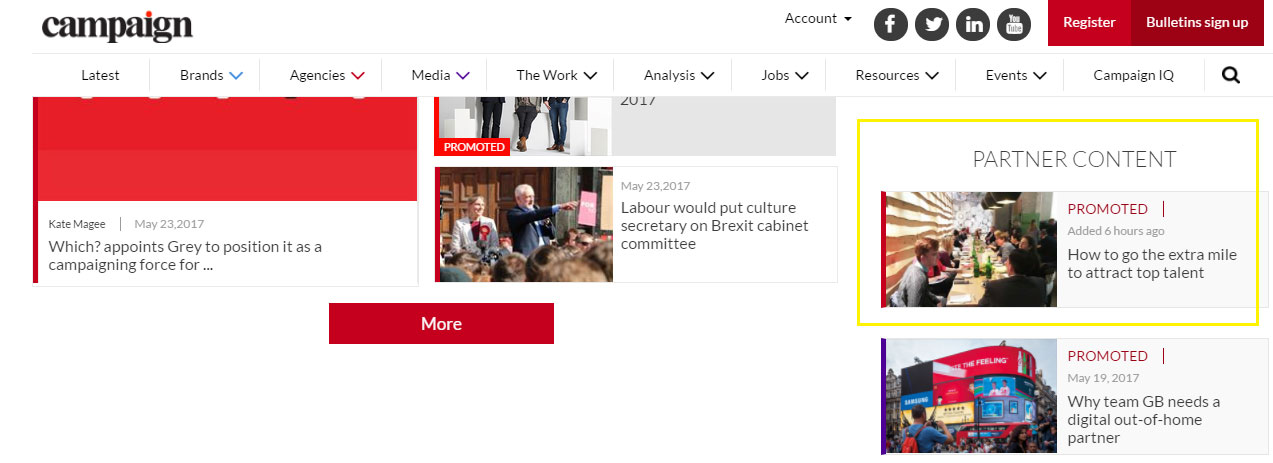
Campaign Live clearly labels their Partner Content to avoid misdirecting users
DONATION-BASED REVENUE
Patreon, PayPal
One of the more unique ways to monetise your content is via donation based revenue platforms such as PayPal or Patreon. This method tends to apply more to those who publish entertainment or creative content.
A good example of people that use this donation based monetisation system are YouTube content creators. Currently, the most common form of monetising YouTube videos is Google Adsense, however this method requires an immense number of video views in order to generate enough income for the creator.
This is where the donation based revenue platforms shine. They allow the audience of the creator to donate (or in the case of Patreon, pledge) an amount of money in order to show their support.
One of these donation based platforms is PayPal. PayPal makes it very easy to send money to other people and therefore, it’s provides an excellent way for an audience to donate easily and quickly. Utilising PayPal for donations is used frequently by Twitch.tv live streamers such as itmeJP, who live streams his videogame sessions, amongst other things.
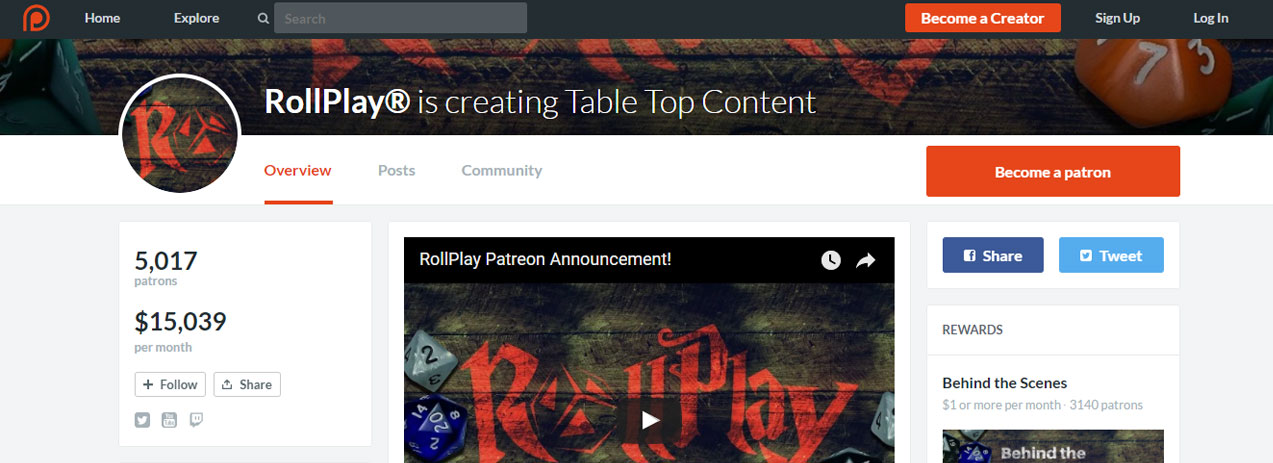
Patreon on the other hand, is a platform that allows an audience to “pledge” a monthly amount of money to their chosen creator (given that the creator has a Patreon account). The creator can also establish “rewards” depending on the pledged amount as an incentive. Patreon is utilised by RollPlay, a show that focuses on various tabletop role playing games, to great effect.
The great effect of this donation based revenue system is that creators with smaller, more niche audiences can now make content creation their full-time job, as long as they have enough support from their audience.
Comments

If you publish content of some form online, whether it be via your blog or other means, it’s likely that you have either thought about or attempted to monetise your content.
Finding the right monetisation strategy for your business can be a challenge. However, each tactic has it’s own unique advantages and disadvantages.
Additionally, due to the variations within the marketing mix from business to business, it’s likely that not of the revenue streams of them will be suitable for your business.
In this article, we explain 6 alternative methods you can use to grow your businesses online revenue. If you have any questions or suggestions, please feel free to leave us a comment!
CPM DISPLAY ADVERTISING
Google Display Network, Uber CPM
CPM (cost per thousand) advertising is a traditional and rather outdated method of website monetization in which the advertiser is charged a fee from the website owner at a flat rate, according to the number of times the advertisement is shown to the website’s visitors.
Typically, CPM advertising can result in some cost-effective campaigns. The main downside of CPM however, is that the actions taken by the users often remain untracked. This makes for difficult campaign tracking as it is relatively futile to assume that users will be able to recall your ad, or take further actions based on mere exposure to a website banner.
CPC ADVERTISING
Google Adsense, Media.net
CPC (Cost Per Click) advertising is a modern version of the traditional CPM display ad model. With cost per click ads and as the name suggests, the advertiser is charged based on the number of clicks their advertisements receive.
In recent years, CPC Advertising has become much more popular in comparison to CPM advertising models, primarily due to one major player – Google Adsense.
The Adsense content network is powered by a wealth of data from Google and enables publishers to display relevant ads automatically on their website, to receive a share of the revenue when these ads are clicked.
AFFILIATE REVENUE
Amazon Affiliates, eBay Partner Network
Affiliate advertising is a commission based revenue system that in a sense, has a lot in common with the CPM and CPC strategies. Similarly, affiliate advertising relies on third party ads being placed on your website.
These ads come from affiliate advertising networks such as Amazon Affiliates, and provide the website owner with a commission for every sale generated as a byproduct of the ad placed on their site. Affiliate revenue can also be referred to as cost per acquisition marketing, or CPA.
Affiliate revenue streams can be a very natural addition to a hobby-blog or reviews website. For example, if you ran a site reviewing science fiction books, you could use Amazon affiliate links within your reviews to receive a portion of the profit.

ThisIsWhyImBroke.com maintains a presence on Reddit, driving traffic to the which is then monitised via Amazon Affiliate commission
PAID-FOR SUBSCRIPTION
Netflix, The Guardian, Campaign Live, Spotify
While consumers become more comfortable with subscription-based services like Netflix and Spotify, a wide range of ‘all-you-can-eat’ subscription model have started to emerge.
As the trend of paying for unlimited access to digital content grows, and the consumer’s behaviour of increased media consumption becomes normalised, new opportunities for publishers and media brands will begin to emerge.
Subscription-based revenue has become increasingly more popular with mainstream news providers like The Guardian but this model can also be just as effective for niche, alternative media sources. As discussed in this article this subscription model has served as a successful alternative to CD revenue for those within the music industry
Perhaps the increased reliance from media companies on subscription based revenue, is a market reaction to the decreased effectiveness of banner ads, which has seen click through rates fall by 44% in recent years.

SPONSORED CONTENT
Business Insider, Campaign Live, Huffington Post
Sponsored Content is when a company pays a publisher to post or produce an article which advertises their services or discusses their agenda in a positive light. Many companies such as the New York Times, Huffington Post and Business Insider have developed ancillary revenue streams through this method of monetisation.
Having mainstream platforms publish content regarding your brand can be highly beneficial. However, sponsored content is also somewhat controversial. This is because sponsored content often lacks the collaborative and authentic nature of an organic story or guest post.
When striving to maintain brand authenticity, it is important for publishers to be upfront with readers about the presence of any sponsored articles. If you are being paid to review electronic products and you do not include a disclosure notice, it could be a huge blow to your credibility if discovered by your audience.

Campaign Live clearly labels their Partner Content to avoid misdirecting users
DONATION-BASED REVENUE
Patreon, PayPal
One of the more unique ways to monetise your content is via donation based revenue platforms such as PayPal or Patreon. This method tends to apply more to those who publish entertainment or creative content.
A good example of people that use this donation based monetisation system are YouTube content creators. Currently, the most common form of monetising YouTube videos is Google Adsense, however this method requires an immense number of video views in order to generate enough income for the creator.
This is where the donation based revenue platforms shine. They allow the audience of the creator to donate (or in the case of Patreon, pledge) an amount of money in order to show their support.
One of these donation based platforms is PayPal. PayPal makes it very easy to send money to other people and therefore, it’s provides an excellent way for an audience to donate easily and quickly. Utilising PayPal for donations is used frequently by Twitch.tv live streamers such as itmeJP, who live streams his videogame sessions, amongst other things.

Patreon on the other hand, is a platform that allows an audience to “pledge” a monthly amount of money to their chosen creator (given that the creator has a Patreon account). The creator can also establish “rewards” depending on the pledged amount as an incentive. Patreon is utilised by RollPlay, a show that focuses on various tabletop role playing games, to great effect.
The great effect of this donation based revenue system is that creators with smaller, more niche audiences can now make content creation their full-time job, as long as they have enough support from their audience.


